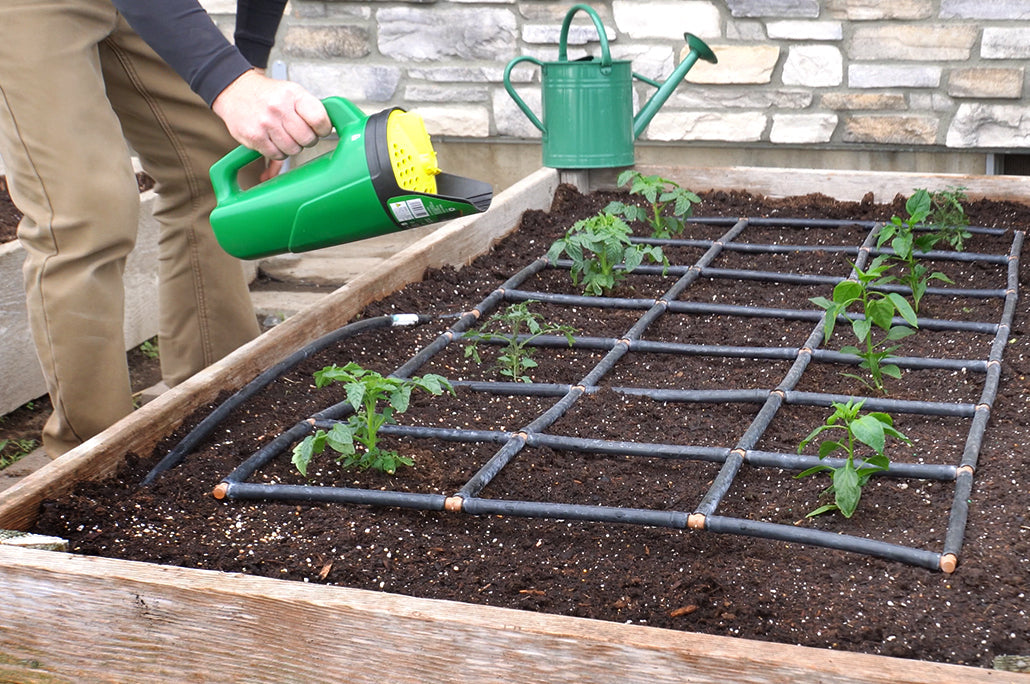A Practical Guide to Garden Fertilization
Developing an effective fertilization strategy is key to a healthy, productive garden. This guide outlines the essentials, from understanding fertilizer types and timing to application methods and best practices-so you can nourish your plants efficiently and sustainably.
1. Start with a MySoil Test
- Why: A MySoil test reveals nutrient levels and pH then provides custom fertilizer recommendations, organic or non-organic, based on your soil needs and helping you select the right fertilizer and avoid over-application.
- How: Use a soil probe, hori-hori, or hand trowel to collect soil from 5-7 spots in your garden, sampling to a consistent depth of 6 inches. Combine the samples in a clean container, mix thoroughly, and remove large debris. Use the provided scoop to add a level sample to the MySoil jar; do not dump out the contents of the jar. Want to see a demonstration? Watch here – How to Take a Soil Sample
Tip: Don’t forget to adjust the square footage on your MySoil test report to get precise fertilizer recommendations for your garden!

2. Choose the Right Fertilizer for You
- Organic:
- Soil Health - Organic fertilizers improve soil structure, boost water retention, and foster beneficial microbes and earthworms.
- Long-Term Benefits - Nutrients are released slowly, providing a steady supply for plants and reducing the risk of over-fertilization or nutrient runoff.
- Sustainability - Often made from recycled natural materials, organic fertilizers promote eco-friendly gardening.
- Consideration - Organic fertilizers can be slower to act, may have variable nutrient content, and sometimes require more effort to apply evenly.
- Non-Organic:
- Fast Results - Non-organic fertilizers often provide immediate nutrients for rapid plant growth or to quickly correct deficiencies.
- Precision - Nutrient content is consistent and clearly labeled, making application easier and results more predictable
- Convenience - Available in various forms (granules, liquids, spikes) and suitable for large-scale or time-sensitive applications
- Cost-Effective (Short-Term): Generally less expensive upfront, especially for single-nutrient needs
3. Timing Your Fertilizer Applications
- Early Spring: Apply the recommended fertilizer before planting to support early growth. You can broadcast apply and incorporate the fertilizer at this time. This is also a great time to add and incorporate compost, mulch, or other organic or pH adjustment amendments.
- Mid to Late Spring: A second application can boost growth during peak season. A side dress application or broadcast application may be appropriate at this timing depending on plant size and height. Using soluble nutrients in a watering can and spreading over the garden is a great technique at this time as well.
- Mid-Summer: For organic gardens, a mid-summer feeding can sustain crops through harvest. Depending on plant size, broadcasting, side dressing, or adding liquid nutrients are suitable methods at this timing.
- Heavy Feeders and High-Density Planting: Crops like tomatoes, corn, and cabbage may need additional feeding as they grow, consider applying every four weeks during active growth. High density plantings, particularly in raised beds or containers will also benefit from monthly fertilizer applications while actively growing.
4. Application Methods
- Broadcasting: Spread fertilizer evenly over the garden and mix into the top 3–4 inches of soil before planting.
- Banding/Row Application: Apply fertilizer in a strip beside the planting row, keeping it away from seeds and roots to prevent burn.
- Starter Solution: For transplants, mix fertilizer with water and pour into the planting hole before setting plants.
- Side-Dressing: Sprinkle fertilizer alongside rows of growing plants and water it in, especially for nitrogen-loving crops or sandy soils.
5. Match Fertilizer to Plant Needs
|
Plant Type |
Fertilizer Approach |
|
Heavy Feeders (Corn, Cantaloupe, Kale, Peppers, Tomatoes) |
Pre-plant and additional feeding during growth |
|
Moderate Feeders (Carrots, Sweet Potatoes, Beets, Pole Beans) |
Pre-plant and occasional liquid feeding |
|
Light Feeders (Peas, Mustard greens, Turnips, Bush Beans) |
Compost-enriched soil, minimal extra fertilizing |
6. Best Practices and Tips
- Water After Fertilizing: Always water thoroughly to help nutrients reach roots.
- Don’t Over-Fertilize: Excess fertilizer can burn plants and harm the environment-follow label directions and MySoil Guidance.
- Foliar Feeding: Use foliar sprays for quick correction of deficiencies, especially micronutrients or in cool spring soils.
- Slow-Release Fertilizers: Consider these for steady nutrient supply, especially in poor or sandy soils.
- Organic Matter: Regularly add compost or organic matter to improve soil structure and nutrient holding. We recommend pre-plant and post-harvest additions in the garden.
Summary Checklist
- Complete a MySoil soil test before fertilizing
- Select the right fertilizer type for your growing philosophy
- Time applications to plant growth stages
- Apply using the best method for your crops
- Water in fertilizers and avoid overuse
- Adjust strategy based on plant response and soil test results
A thoughtful fertilization strategy ensures a nutrient dense crop, robust plant growth, healthier soil, and bountiful harvests. If you would like to see a video demonstration of the techniques discussed, please watch How To Fertilize A Garden hosted by MySoil CEO Kris Borgman.

Share:
Composting 101: Simple and Essential Tips for Creating Nutrient Rich Compost